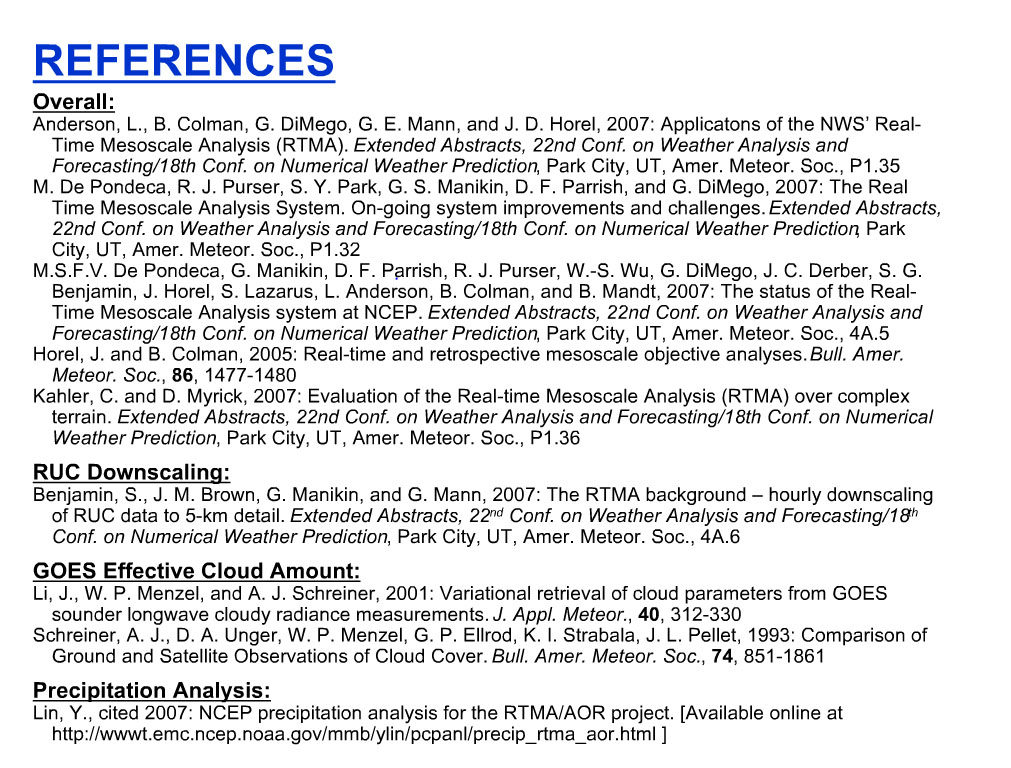Introduction
Outline
Learning Objectives
Why RTMA?
Applications of RTMA
Applications of RTMA - Discussion
Inputs
Outputs
Feedback
All Together
RTMA Output Variables And Data Flow
Example - Isolated Dense Fog
Example - Subtropical Storm Andrea
Terrain Differences
Method/Implications
Example
Observations Going Into RTMA
Quality Control
GSI Flow And Analysis Variables
Consequence Of Assuming Small Background Error For Velocity Potential
How Close Draw To Obs
Obs Radius Of Influence
Terrain Effect On Obs Influence
Covariance Pictures
Example - Analysis Increment Shape Influence By Terrain
Explanation
Example - Temperature
Example - Dewpoint
Example - Wind Speed
Bad First Guess
RUC Can't Resolve a Feature
Bad Observations
Terrain Variance
Terrain
Instrument Siting
Real Scenario
How GSI Handles It
Result
1
2
3
Input Data
Example
Limitations
Affected By Fire Smoke
Background 1
Background 2
Example 1
Example 2
Overall
Limitations for GSI Fields
Limitations for Precip and Cloud Products

Contributors
COMET Sponsors
The COMET® Program is sponsored by NOAA National Weather Service (NWS), with additional funding by:
- Naval Meteorology and Oceanography Command (NMOC)
- Air Force Weather Agency (AFWA)
- National Environmental Satellite, Data, and Information Service (NESDIS)
- Environment Canada - Meteorological Service of Canada (MSC)
- Australian Bureau of Meteorology (BoM)
Project Contributors
Principal Science Author
- Dr. Stephen Jascourt — UCAR/COMET
Multimedia Authoring
- Dr. Stephen Jascourt — UCAR/COMET
- Lon Goldstein — UCAR/COMET
Audio Editing/Production
- Seth Lamos — UCAR/COMET
Audio Narration
- Dr. Stephen Jascourt — UCAR/COMET
Computer Graphics/Interface
- Dr. Stephen Jascourt — UCAR/COMET
- Lon Goldstein — UCAR/COMET
Data Provided by
- NOAA
COMET HTML Integration Team 2021
- Tim Alberta — Project Manager
- Dolores Kiessling — Project Lead
- Steve Deyo — Graphic Artist
- Ariana Kiessling — Web Developer
- Gary Pacheco — Lead Web Developer
- David Russi — Translations
- Tyler Winstead — Web Developer
COMET Staff
Director
- Dr. Timothy Spangler
Deputy Director
- Dr. Joe Lamos
Business Manager/Supervisor of Administration
- Elizabeth Lessard
Administration
- Lorrie Alberta
- Michelle Harrison
- Hildy Kane
Graphics/Media Production
- Steve Deyo
- Seth Lamos
- Brennan McGill
Hardware/Software Support and Programming
- Tim Alberta (IT Manager)
- James Hamm
- Ken Kim
- Mark Mulholland
- Dan Riter
- Carl Whitehurst
- Malte Winkler
Instructional Design
- Patrick Parrish (Production Manager)
- Dr. Alan Bol
- Lon Goldstein
- Dr. Vickie Johnson
- Bruce Muller
- Dwight Owens (Alphapure Design Studio)
- Marianne Weingroff
Meteorologists
- Dr. Greg Byrd (Project Cluster Manager)
- Wendy Schreiber-Abshire (Project Cluster Manager)
- Dr. William Bua
- Patrick Dills
- Tom Dulong
- Dr. Stephen Jascourt
- Matthew Kelsch
- Dolores Kiessling
- Dr. Arlene Laing
- Dr. Elizabeth Mulvihill Page
- Dr. Doug Wesley
Spanish Translations
- David Russi
NOAA/National Weather Service - Forecast Decision Training Branch
- Anthony Mostek (NWS COMET Branch Chief [acting] and Satellite Training Leader)
- Dr. Richard Koehler (Hydrology Training Lead)
- Brian Motta (IFPS Training)
- Dr. Robert Rozumalski (SOO Science and Training Resource [SOO/STRC] Coordinator)
- Shannon White (AWIPS Training)
Meteorological Service of Canada Visiting Meteorologists
- Phil Chadwick
- James Cummine